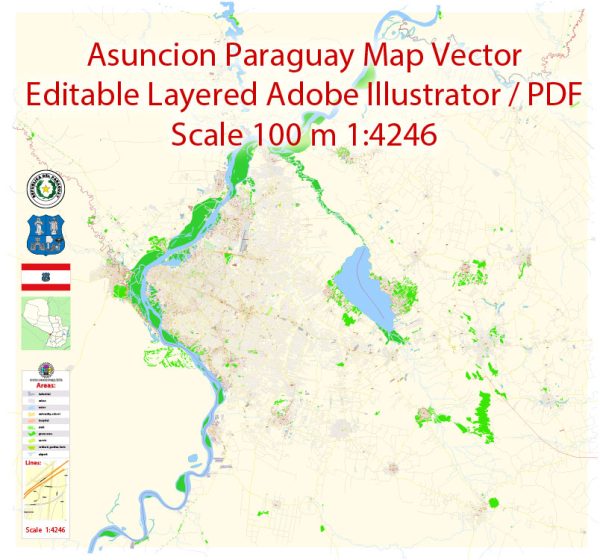Asunción, the capital and largest city of Paraguay, has a rich political and economic history that spans several centuries.
Vectormap.Net provide you with the most accurate and up-to-date vector maps in Adobe Illustrator, PDF and other formats, designed for editing and printing. Please read the vector map descriptions carefully.
Here’s a detailed overview of key milestones in both aspects:
Political History:
Pre-Colonial Period:
- Before the arrival of Spanish colonizers, the region that is now Paraguay was inhabited by various indigenous groups, including the Guarani people.
- The Guarani were skilled agriculturalists, and their societies were organized in a decentralized manner.
Spanish Colonial Era (16th to 19th centuries):
- In 1537, Spanish explorer Juan de Salazar y Espinosa founded Asunción, making it one of the oldest cities in South America.
- Asunción became a significant center for the Spanish colonial administration in the region, and it played a crucial role in the Spanish colonial trade network.
- The Guarani people resisted Spanish rule, leading to conflicts and uprisings, notably the Guarani War (1754-1756).
- The region later became part of the Viceroyalty of the Río de la Plata.
Independence and Early Nationhood (19th century):
- Paraguay declared its independence from Spanish rule on May 14, 1811, marking the beginning of its nationhood.
- Paraguay’s first leader was José Gaspar Rodríguez de Francia, who ruled as a dictator until his death in 1840. His policies aimed at maintaining independence and preventing foreign influence.
- Following Francia, Carlos Antonio López and his son Francisco Solano López governed Paraguay, focusing on modernization and economic development.
War of the Triple Alliance (1864-1870):
- One of the most devastating conflicts in South American history, the War of the Triple Alliance, involved Paraguay fighting against Brazil, Argentina, and Uruguay.
- The war resulted in significant loss of life and had a profound impact on Paraguay’s economy and demographics.
20th Century:
- Paraguay experienced political instability, with periods of military rule interspersed with short-lived civilian governments.
- The Chaco War (1932-1935) with Bolivia over the Chaco region influenced Paraguay’s national identity and territorial boundaries.
- In 1954, General Alfredo Stroessner seized power in a coup and established a long-lasting authoritarian regime that lasted until 1989.
Post-Stroessner Era (Late 20th Century Onward):
- Stroessner’s dictatorship came to an end in 1989, leading to a transition to democratic governance.
- Paraguay has experienced periods of political stability and change since then, with various political parties participating in the democratic process.
- Economic challenges, corruption, and social issues have continued to shape the country’s political landscape.
Economic History:
Colonial Economy:
- The colonial economy was based on agriculture, with emphasis on yerba mate, tobacco, and later, cotton.
- Indigenous populations were often subjected to forced labor in encomiendas.
Post-Independence Economic Policies:
- The López administrations in the mid-19th century implemented policies to promote economic self-sufficiency, including state intervention in key industries and infrastructure development.
- The War of the Triple Alliance had severe economic consequences, with widespread destruction and loss of productive capacity.
20th Century Economic Policies:
- Stroessner’s regime implemented economic policies that favored agribusiness, particularly soy and cattle farming, attracting foreign investment.
- The economy became increasingly centralized, with a concentration of wealth in the hands of a few.
- The country faced economic challenges, including inflation and external debt.
Late 20th Century Onward:
- The post-Stroessner era saw efforts to liberalize and diversify the economy.
- Paraguay has been a major global producer of soybeans, contributing significantly to its export earnings.
- Challenges include issues related to land distribution, poverty, and informal economic activities.
In summary, Asunción and Paraguay have a complex history marked by colonization, wars, dictatorships, and efforts at economic development. The country has made strides in establishing democratic governance but continues to grapple with economic and social challenges.


 Author: Kirill Shrayber, Ph.D.
Author: Kirill Shrayber, Ph.D.